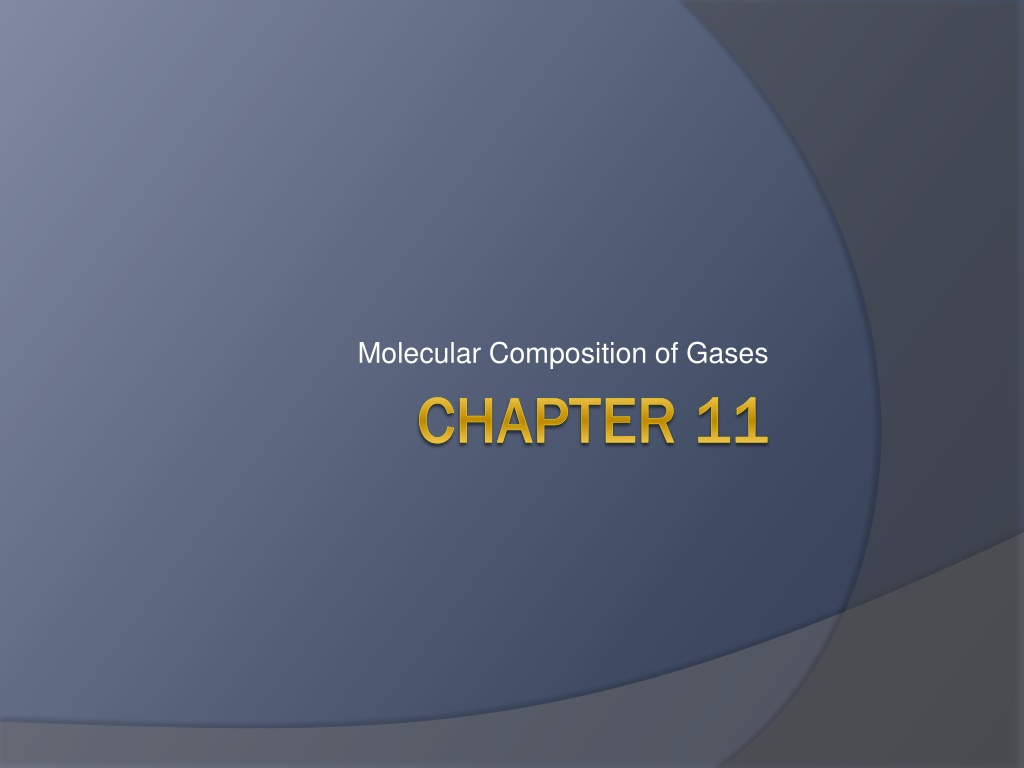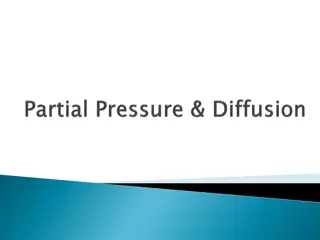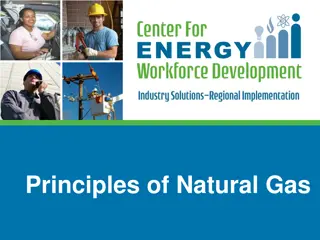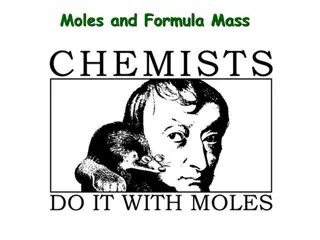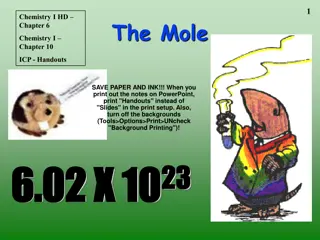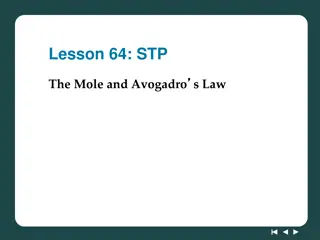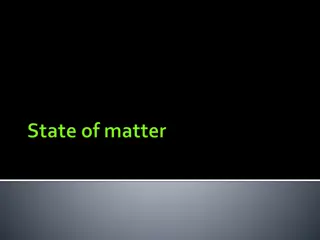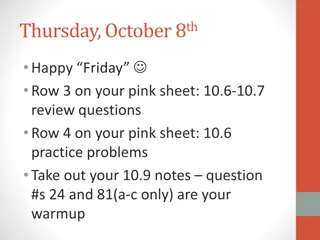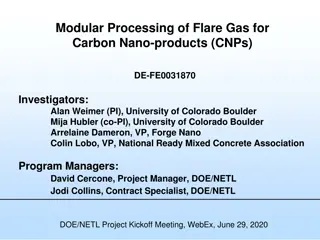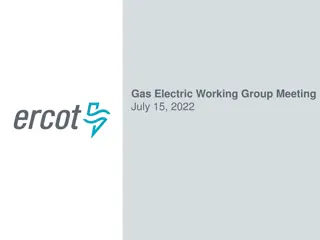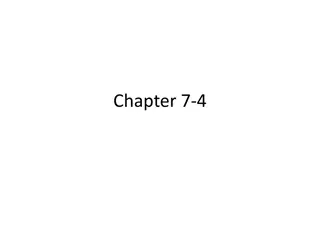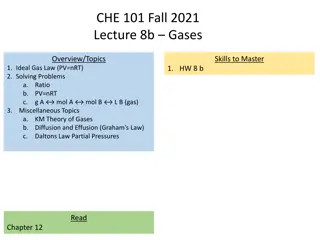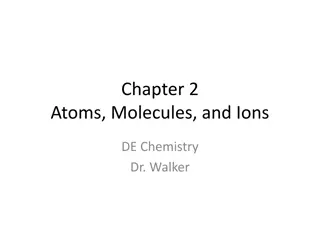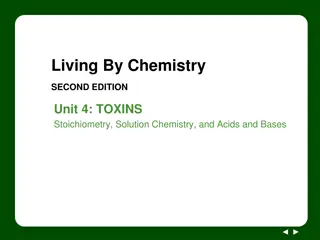Understanding Gas Laws and Avogadro's Contributions
This chapter delves into the molecular composition of gases, exploring topics such as volume-mass relationships, Gay-Lussac's studies on gas volumes in reactions, the law of combining volumes of gases, and Avogadro's groundbreaking findings. Gay-Lussac's work posed challenges to Dalton's atomic theory, but Avogadro's insights in 1811 provided a way to reconcile these discrepancies without violating the concept of indivisible atoms.
Download Presentation

Please find below an Image/Link to download the presentation.
The content on the website is provided AS IS for your information and personal use only. It may not be sold, licensed, or shared on other websites without obtaining consent from the author. Download presentation by click this link. If you encounter any issues during the download, it is possible that the publisher has removed the file from their server.
E N D
Presentation Transcript
Molecular Composition of Gases CHAPTER 11 CHAPTER 11
Volume-Mass Relationships of Gases Section 1 Section 1
Measuring and Comparing the Volumes of Reacting Gases Early 1800s, Gay-Lussac studied gas volume relationships with chemical reaction between H and O Observed 2 L H can react with 1 L O to form 2 L of water vapor at constant temperature and pressure Hydrogen gas + oxygen gas water vapor 2 L 1 L 2 volumes 1 volume 2 L 2 volumes
Reaction shows 2:1:2 relationship between volumes of reactants and product Ratio applies to any proportions (mL, L, cm3) Gay-Lussac also noticed ratios by volume between other reactions of gases Hydrogen gas + chlorine gas hydrogen chloride gas 1 L 1 L 2 L
Law of Combining Volumes of Gases 1808 Gay-Lussac summarized results in Gay-Lussac s law of combining volumes of gases at constant temperature and pressure, the volumes of gaseous reactants and products can be expressed as ratios of small whole numbers
Avogadros Law Important point of Dalton s atomic theory: atoms are indivisible Dalton also thought particles of gaseous elements exist in form of single atoms Believed one atom of one element always combines with one atom of another element to form single particle of product
Gay-Lussacs results presented problem for Dalton s theory Ex. Reactions like formation of water Hydrogen gas + oxygen gas water vapor 2 L 1 L 2 L Seems that oxygen involved would have to divide into two parts
1811 Avogadro found way to explain Gay- Lussac s simple ratios of combining volumes without violating Dalton s idea of indivisible atoms Rejected Dalton s idea that reactant elements are always in monatomic form when they combine to form products Reasoned these molecules could contain more than 1 atom
Avogadros law equal volumes of gases at the same temperature and pressure contain equal numbers of molecules At the same temp and pressure, volume of any given gas varies directly with the number of molecules
1 mol CO2 at STP = 22.4 L 1 mol O2 at STP = 22.4 L 1 mol H2 at STP = 22.4 L
Consider reaction of H and Cl to produce HCl According to Avogadro s law, equal volumes of H and Cl contain same number of molecules b/c he rejected Dalton s theory that elements are always monatomic, he concluded H and Cl components must each consist of 2 or more atoms joined together
Simplest assumption was that H and Cl molecules had 2 atoms each Leads to following balanced equation: H2(g) + Cl2(g) 2HCl(g) 1 volume 1 volume 1 molecule 1 molecule 2 volumes 2 molecules If the simplest formula for hydrogen chloride, HCl indicates molecule contains 1 H and 1 Cl Then the simplest formulas for hydrogen and chlorine must be H2and Cl2
Avogadros law also indicates that gas volume is directly proportional to the amount of gas, at given temp and pressure V = kn k = constant n = amount of gas in moles
Molar Volume of Gases Remember 1 mol of substance contains 6.022 x 1023 According to Avogadro s law, 1 mol of any gas occupies same volume as 1 mol of any other gas at same temperature and pressure, even though masses are different Standard molar volume of gas volume occupied by 1 mol of gas at STP = 22.4 L
Knowing volume of gas, you can use 1mol/22.4 L as conversion factor Can find number of moles Can find mass Can also use molar volume to find volume if you have number of moles or mass
Sample Problem A chemical reaction produces 0.0680 mol of oxygen gas. What volume in liters is occupied by this gas sample at STP?
1. Analyze Given: moles of O2 = 0.0680 mol Unknown: volume of O2 in liters at STP
2. Plan moles of O2 liters of O2 at STP The standard molar volume can be used to find the volume of a known molar amount of a gas at STP
Practice Problems At STP, what is the volume of 7.08 mol of nitrogen gas? 159 L N2 A sample of hydrogen gas occupies 14.1 L at STP. How many moles of the gas are present? 0.629 mol H2 At STP, a sample of neon gas occupies 550. cm3. How many moles of neon gas does this represent? 0.0246 mol Ne
Sample Problem A chemical reaction produced 98.0 mL of sulfur dioxide gas, SO2, at STP. What was the mass (in grams) of the gas produced?
1. Analyze Given: volume of SO2 at STP = 98.0 mL Unknown: mass of SO2 in grams
2. Plan liters of SO2 at STP moles of SO2 grams of SO2
3. Compute = 0.280 g SO2
Practice Problems What is the mass of 1.33 104 mL of oxygen gas at STP? 19.0 g O2 What is the volume of 77.0 g of nitrogen dioxide gas at STP? 37.5 L NO2 At STP, 3 L of chlorine is produced during a chemical reaction. What is the mass of this gas? 9 g Cl2
The Ideal Gas Law Section 2 Section 2
A gas sample can be characterized by 4 quantities 1. Pressure 2. Volume 3. Temperature 4. Number of moles
Number of moles present always affects at least one of the other 3 quantities Collision rate per unit area of container wall depends on number of moles Increase moles, increase collision rate, increase pressure
Pressure, volume, temperature, moles are all interrelated A mathematical relationship exists to describe behavior of gas for any combination of these conditions Ideal gas law mathematical relationship among pressure, volume, temperature, and number of moles of a gas
Derivation of Ideal Gas Law Derived by combining the other gas laws Boyle s law: at constant temp, the volume of a given mass of gas is inversely proportional to the pressure.
Charless law: At constant pressure, volume of given mass of gas is directly proportional to Kelvin temperature V T Avogadro s law: at constant temp and pressure, volume of given mass of gas is directly proportional to the number of moles V n
Volume is proportional to pressure, temp and moles in each equation Combine the 3: Can change proportion to equality by adding constant, this time R
This equation says the volume of a gas varies directly with the number of moles of gas and its Kelvin temperature Volume also varies inversely with pressure
Ideal gas law combines Boyles, Charless, Gay-Lussac s, and Avogadro s laws Ex: PV = nRT n and T are constant, nRT is constant b/c R is also constant This makes PV = constant which is Boyle s law
The Ideal Gas Constant Ideal gas constant R Value depends on units for volume, pressure, temp Unit of R Value of R 62.4 Unit of P Unit of V Unit of T Unit of n mmHg L K Mol 0.0821 Atm L K Mol 8.314 Pa m3 K Mol 8.314 kPa L K Mol
Sample Problem What is the pressure in atmospheres exerted by a 0.500 mol sample of nitrogen gas in a 10.0 L container at 298 K?
1. Analyze Given: V of N2 = 10.0 L n of N2 = 0.500 mol T of N2 = 298 K Unknown: P of N2 in atm
2. Plan n,V,T P The gas sample undergoes no change in conditions Therefore, the ideal gas law can be rearranged and used to find the pressure as follows
3. Compute = 1.22 atm
Practice Problems What pressure, in atmospheres, is exerted by 0.325 mol of hydrogen gas in a 4.08 L container at 35 C? 2.01 atm A gas sample occupies 8.77 L at 20 C.What is the pressure, in atmospheres, given that there are 1.45 mol of gas in the sample? 3.98 atm
What is the volume, in liters, of 0.250 mol of oxygen gas at 20.0 C and 0.974 atm pressure? 6.17 L O2 A sample that contains 4.38 mol of a gas at 250 K has a pressure of 0.857 atm. What is the volume? 105 L How many liters are occupied by 0.909 mol of nitrogen at 125 C and 0.901 atm pressure? 33.0 L N2
What mass of chlorine gas, Cl2, in grams, is contained in a 10.0 L tank at 27 C and 3.50 atm of pressure? 101 g Cl2 How many grams of carbon dioxide gas are there in a 45.1 L container at 34 C and 1.04 atm? 81.9 g CO2 What is the mass, in grams, of oxygen gas in a 12.5 L container at 45 C and 7.22 atm? 111 g O2
A sample of carbon dioxide with a mass of 0.30 g was placed in a 250 mL container at 400. K. What is the pressure exerted by the gas? 0.90 atm
Finding Molar Mass or Density from Ideal Gas Law If P, V, T and mass are known you can calculate number of moles (n) in sample Can calculate molar mass (g/mol) Equation shows relationship between density, P, T, molar mass Mass divided by molar mass gives moles Substitute m/M for n in equation PV=nRT
Sample Problem At 28 C and 0.974 atm, 1.00 L of gas has a mass of 5.16 g. What is the molar mass of this gas?
1. Analyze Given: P of gas = 0.974 atm V of gas = 1.00 L T of gas = 28 C + 273 = 301 K m of gas = 5.16 g Unknown: M of gas in g/mol
2. Plan P, V, T, m M You can use the rearranged ideal gas law provided earlier to find the answer
3. Compute = 131 g/mol
Practice Problems What is the molar mass of a gas if 0.427 g of the gas occupies a volume of 125 mL at 20.0 C and 0.980 atm? 83.8 g/mol What is the density of a sample of ammonia gas, NH3, if the pressure is 0.928 atm and the temperature is 63.0 C? 0.572 g/L NH3
